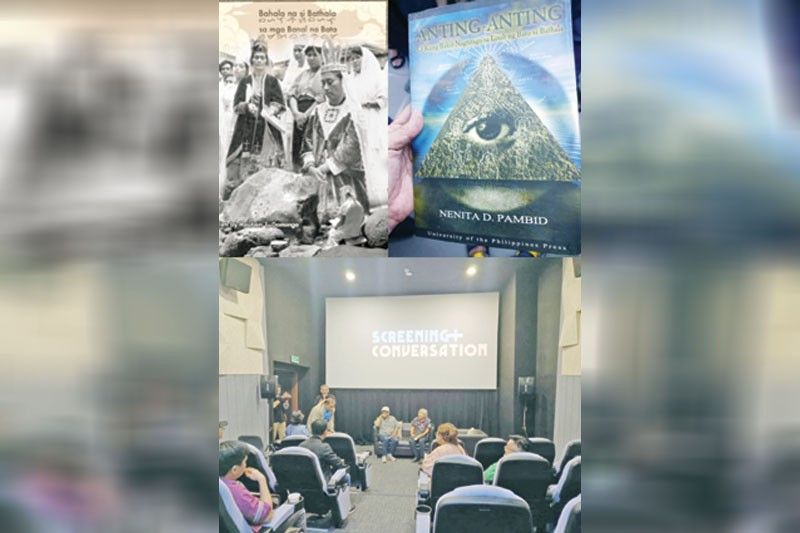Into the mystic


Book author and anthropologist Tita Pambid Domingo laments that everything, even the once occult amulet, can be seen on the internet, and if this is the case there is no reason holding back showing her husband Reuben Domingo’s “Bahala na si Bathala sa mga Banal na Bata,” which uses as anchor her book “Anting-anting: o Kung Bakit Nagtatago sa Loob ng Bato si Bathala” (UP Press 2000, out of print) filmed over decades through several field and exposure trips to the devotional groups at the foot of Mount Banahaw, to a wider though altogether select audience.
The issue of folk religion is always a delicate one, especially for a people protective of their customs and rituals stretching generations, and the documentarist or filmmaker has to tread the fine line between presenting the subject out of genuine interest if not contained advocacy, and mere curiosity better fit for tourists and dilettantes.
On the third Saturday of July as the country barely began to mourn the passing of poet Mariano Kilates, the Domingos’ film “Bahala na si Bathala” was screened to a modest sized audience at the Mowelfund’s Dengcar theater on Rosario Drive, and the effect was not unlike imparting a bit of enlightenment itself, as the now US-based couple returned to old stomping grounds at the foot of Banahaw with the Tres Persona Solo Dios, Ciudad Mistica and Justice Cave among other puestos of love, devotion, surrender, with the 108-minute documentary as sheer testament for a better understanding of talismans.
Seed of the film is a field trip in the early 1990s of the class of UP anthropology professor Prospero Covar, of which Tita Pambid is one of the students, where the professor explains the dynamic of folk religion in Mount Banahaw, long considered a mystical mountain with its healing powers, occult streams and devotional sects. Admittedly such esoterica may be an acquired taste, but Covar puts it forth in such a way as to make the listener informed and aware of the intersections of folk beliefs and the more established religion of huge churches.
Place this then against the backdrop of the filmmaker Reuben’s ruminations at film’s start about waking each morning during a boyhood in Quezon City, and espying from a distance the outline of Banahaw or is it the Sierre Madre mountain range from the window of his parents’ house. Further context is provided when Reuben mentions how he made a trip to Quezon province and its foothills seeking out the faithful upon reading an article in Ermita magazine in the summer of 1976, which included a photo spread of white clad women bathing in waterfalls a la Rio Locsin or Tetchie Agbayani, and how he felt like an outsider among the acolytes. He relates how in fact he had a generally restful sleep later in the then unspoiled rustic outdoors, though feeling a little itchiness in body after his ablutions downstream.
It is fitting then as per credits and mentioned by the filmmakers post-screening, that the film’s title is given by Pepito Bosch, the famous bohemian of Ermita both the district and the magazine, which he had written on a drawing and since appropriated by the documentarist in a kind of revenge of the folklorists, though a tale once related by Bosch (star of the long-lost indie short “Shaman Wars” directed by Ermita magazine editor Krip Yuson) could also be worthy subtext. As a young man from De La Salle Bosch and his posse were walking the wilds somewhere in our blessed archipelago when they came upon a colony of nude natives in the mountain fastness, and the city bred reveled or were sort of dumbfounded at the utter lack of shame or artifice the naked lumad went about their everyday lives, it was as if the group had time traveled (but which way, backward or forward?) and chanced upon people before the arrival of colonizers, or was this back to the post-colonial future? Hence the concept of shame and guilt may have been introduced by the West, and likely also that of the seven deadly sins.
There are a number of notable interviews within the film, including ones with the so-called Suprema in the mystical city in what could be Dolores town, and a painter of the new Jerusalem spanning years and how he considers the act of putting brush to canvas as a spiritual endeavor, something that brings the painter closer to God. Thus, he says, he prefers complete silence in secluded quarters rather than the hustle and bustle to the tune of rock and roll most modernists are used to.
The Rizalistas and their belief that the national hero is an incarnation of the Hesu Kristo are made mention of, a kind of brown Christ for the poor folk who walk the brown earth. Even these days Tita Pambid has second thoughts disclosing such esoteric narratives of this “lihim na karunungan” or occult knowledge. In the wrong hands such material could be misinterpreted if not misused by the malicious or impure of heart.
Reuben Domingo advised one textile designer in the audience afterwards to get to know first the subject he is about to use as material for his projected clothing ware, not everything should serve the ends of commerce: the user must respect the used by giving back. To immerse oneself into the mystic is essential, more so for a generation fast forgetting the oracions and prayers and humble unspoiled ways of the old folks.
- Latest
- Trending

























 Exclusive
Exclusive






